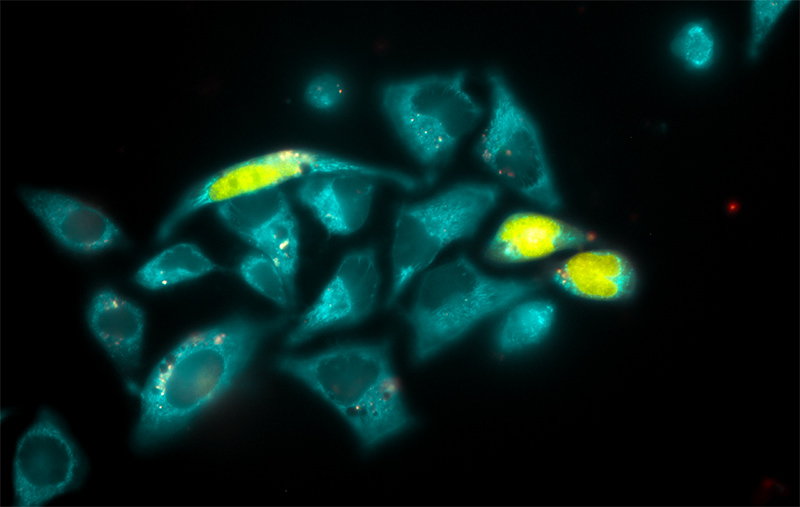打开和关闭细胞
Ngo team creates cellular control system from hepatitis C genome

John Ngo, assistant professor of biomedical engineering. Jackie Riccardi拍摄
大多数药物都是对付疾病的钝器。抗抑郁药会让整个大脑充满血清素。抗生素会地毯式轰炸你肠道里的所有细菌,把好的细菌和坏的细菌一起杀死。Traditional chemotherapy attacks the fast-growing cells in your body, laying waste to tumors, but also hair follicles and bone marrow.
合成生物学领域——科学家们重新设计现有的生物系统来完成新的工作——提供了一种更细致入微的方法:更精确、更有选择性地起作用的细胞疗法。例如,如果我们可以调整免疫系统,让它听从我们的命令——训练它攻击肿瘤,而不是把它的拳头留给外来入侵者,那会怎么样?This type of “immunotherapy” is a long-standing goal of modern biology, and for some cancers, like non-Hodgkin’s lymphoma, it’s already proving effective. But for immunotherapy—and for all medicines based on living human cells—there’s a sticky problem: once you train cells to attack a tumor, or kill bacteria, or build cartilage in an arthritic knee, how do you turn them off when the job is done?
波士顿大学生物医学工程助理教授John Ngo说:“医生面临的一个挑战是,在这些生物还在体内的时候控制它们,让它们发挥治疗作用,同时又不让它们失控。”“这是一个新的范例,澳门威尼斯人注册如何控制治疗细胞的规则仍有待编写。”
Ngo and his collaborators have come up with a tool that offers a means of control, and it comes from a seemingly unlikely source: the hepatitis C genome. 当与广泛使用的抗病毒药物配对时,新系统提供了一种新颖的工具:一种高度特异性的方法,通过现有的、经过验证的药物来打开和关闭工程细胞。该澳门威尼斯人注册网站研究小组将他们的发现发表在7月份的《自然方法》杂志上。
“最大的问题是,我们能否设计细胞来做我们想要的治疗应用,”生物医学工程助理教授Wilson Wong说,他与Ngo共同获得了波士顿大学点火奖的相关澳门威尼斯人注册网站研究。Wong’s ultimate goal is to remove immune system T cells from patients, genetically engineer them to find cancer, and then return them to a patient’s body, controlling them with a system like Ngo’s. “What John has developed here is a drug-controllable system,” says Wong. “你可以改变添加药物的时间,你需要多长时间的治疗,以及你需要多强的反应。”
Ngo说:“这项工作表明,我们可以重新利用现有的药物来控制治疗细胞,这种方法不仅具有选择性,而且从药物开发的角度来看也是有效的,因为这些药物已经存在。”“该系统的一个方便的好处是,我们已经确切地知道这些药物的有效期。”

科学家们已经开发出了控制工程细胞的策略,比如使用植物激素、人类蛋白质和抗生素。但这些策略都有缺陷。For instance, overuse of antibiotics can contribute to antibiotic resistance, and also indiscriminately kill bacteria in a patient’s gut. “我们知道,这些肠道细菌实际上影响了许多癌症治疗的效果,包括细胞治疗和基本化疗,”Ngo说。“So ideally, we’d like to have those systems in place.”
Ngo and his team, which included Elliot Tague (ENG’21), Hannah Dotson (ENG’21), Shannon Tunney (ENG’21), and D. Christopher Sloas (ENG’21), started to look for a better way. They wanted to engineer a system that would interact with a safe, predictable, widely available medication. 他们希望这种药物能与通常不存在于人体中的蛋白质结合,这样它就不会对人体造成严重破坏。
对于这个系统的关键,他们选定了一种蛋白酶——一种分子“剪刀”——它可以切割其他蛋白质。他们选择的这种特殊蛋白酶来自丙型肝炎病毒,通常存在于一个较长的分子中间。当被激活时,蛋白酶将长分子切成小块。Ngo提供了一个生动的比喻:“如果我的头是切割的部分,它会咬掉我肩膀上的手臂,让它们松开。”In hepatitis C, the process is how the virus replicates and spreads in the body. But antiviral drugs stop the protease in its tracks.
Knowing the mechanism, Ngo and his team wondered how they could use it for their own ends.
They took the isolated protease molecule and attached new “arms” to either end, creating what Ngo called a “Frankenstein protein.” The arms, when linked to the protease, act as transcription factors that tell a gene to turn on or off. 被切掉后,它们就停止了功能。通过添加或移除抗病毒药物,澳门威尼斯人注册网站研究人员告诉蛋白酶是切割还是不切割。他们将整个系统称为“LInC”,即配体诱导连接,这意味着药物可以命令长蛋白保持完整,或者将自身切成碎片。
该系统是模块化的,可以用来构建和断开不同类型的分子,从而打开和关闭不同的基因。Ngo and Wong hope the system will offer a new tool for cancer researchers, and may eventually lead to tailored cancer therapies. “Everybody is racing toward getting a more controllable system,” says Wong.
“The system is very modular and very generalizable,” says Ngo. “就基因开启或关闭而言,我们不知道哪种类型的系统最有用,因此拥有可用于将药物控制设计成许多不同细胞特征的工具将非常重要。”I think if we’re creative enough, we can figure out how to control essentially any protein, using this type of technology.”

评论与讨论
波士顿大学缓和评论,以促进知情的、实质性的、文明的对话。辱骂、亵渎、自我推销、误导、语无伦次或离题的评论将被拒绝。版主在正常营业时间(EST)有澳门威尼斯人注册,只能接受用英语写的评论。统计数据或事实必须包含引文或引文链接。